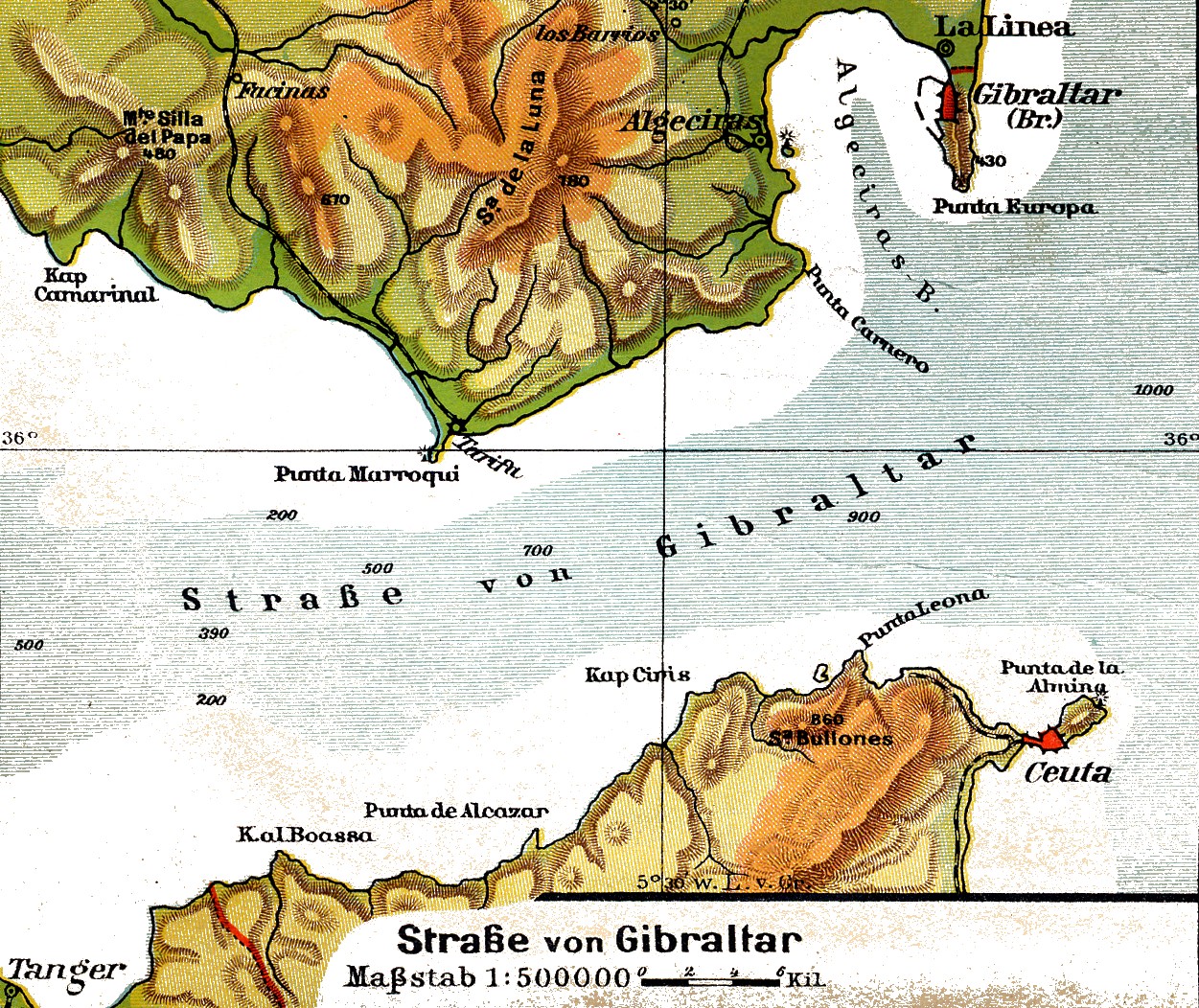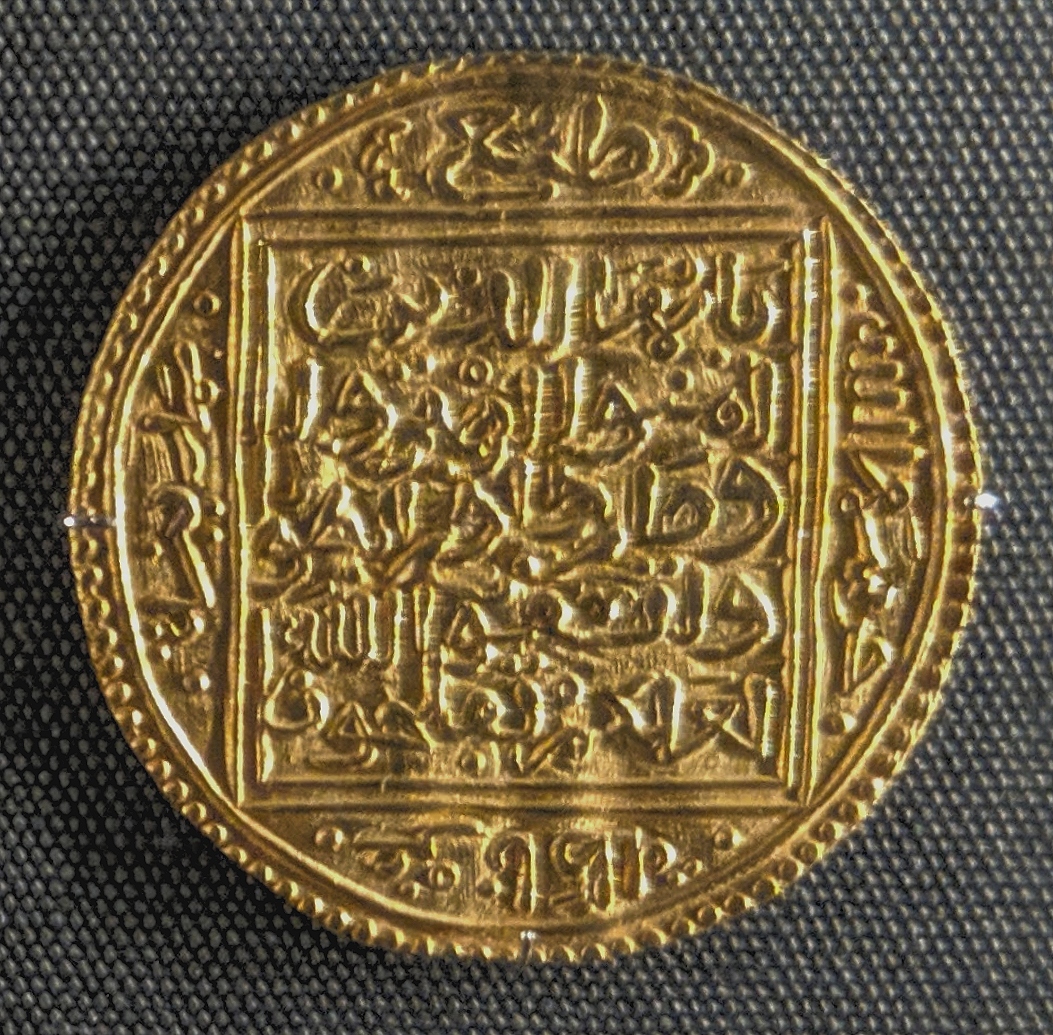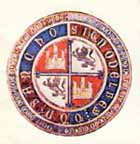|
Abu Al-Hasan Ali Ibn Othman
Abu Al-Hasan 'Ali ibn 'Othman (c. 1297 – 24 May 1351), () was a sultan of the Marinid dynasty who reigned in Morocco between 1331 and 1348. In 1333 he captured Gibraltar from the Castilians, although a later attempt to take Tarifa in 1339 ended in fiasco. In North Africa he extended his rule over Tlemcen and Hafsid Ifriqiya, which together covered the north of what is now Algeria and Tunisia. Under him the Marinid realms in the Maghreb briefly covered an area that rivaled that of the preceding Almohad Caliphate. However, he was forced to retreat due to a revolt of the Arab tribes, was shipwrecked, and lost many of his supporters. His son Abu Inan Faris seized power in Fez. Abu Al-Hasan died in exile in the High Atlas mountains. Early years Abu al-Hassan was the son of Marinid ruler Abu Sa'id Uthman II and an Abyssinian mother. He had a dark complexion, and was known as the 'Black Sultan' of Morocco. He succeeded his father Abu Sa'id Uthman II in 1331. Abu al-Hassan married ... [...More Info...] [...Related Items...] OR: [Wikipedia] [Google] [Baidu] |
Marinid Sultanate
The Marinid Sultanate was a Berber Muslim empire from the mid-13th to the 15th century which controlled present-day Morocco and, intermittently, other parts of North Africa (Algeria and Tunisia) and of the southern Iberian Peninsula (Spain) around Gibraltar. It was named after the Banu Marin (, Berber: ''Ayt Mrin''), a Zenata Berber tribe. The sultanate was ruled by the Marinid dynasty ( ar, المرينيون ), founded by Abd al-Haqq I.C.E. Bosworth, ''The New Islamic Dynasties'', (Columbia University Press, 1996), 41-42. In 1244, after being at their service for several years, the Marinids overthrew the Almohads which had controlled Morocco. At the height of their power in the mid-14th century, during the reigns of Abu al-Hasan and his son Abu Inan, the Marinid dynasty briefly held sway over most of the Maghreb including large parts of modern-day Algeria and Tunisia. The Marinids supported the Emirate of Granada in al-Andalus in the 13th and 14th centuries and made a ... [...More Info...] [...Related Items...] OR: [Wikipedia] [Google] [Baidu] |
Almohad Caliphate
The Almohad Caliphate (; ar, خِلَافَةُ ٱلْمُوَحِّدِينَ or or from ar, ٱلْمُوَحِّدُونَ, translit=al-Muwaḥḥidūn, lit=those who profess the unity of God) was a North African Berber Muslim empire founded in the 12th century. At its height, it controlled much of the Iberian Peninsula (Al Andalus) and North Africa (the Maghreb). The Almohad movement was founded by Ibn Tumart among the Berber Masmuda tribes, but the Almohad caliphate and its ruling dynasty were founded after his death by Abd al-Mu'min al-Gumi. Around 1120, Ibn Tumart first established a Berber state in Tinmel in the Atlas Mountains. Under Abd al-Mu'min (r. 1130–1163) they succeeded in overthrowing the ruling Almoravid dynasty governing Morocco in 1147, when he conquered Marrakesh and declared himself caliph. They then extended their power over all of the Maghreb by 1159. Al-Andalus soon followed, and all of Muslim Iberia was under Almohad rule by 1172. The turning p ... [...More Info...] [...Related Items...] OR: [Wikipedia] [Google] [Baidu] |
Algeciras
Algeciras ( , ) is a municipalities in Spain, municipality of Spain belonging to the province of Cádiz, Andalusia. Located in the southern end of the Iberian Peninsula, near the Strait of Gibraltar, it is the largest city on the Bay of Gibraltar ( es, Bahía de Algeciras, link=no). The Port of Algeciras is List of busiest ports in Europe, one of the largest ports in Europe and the world in three categories: List of world's busiest container ports, container, List of world's busiest ports by cargo tonnage, cargo and transshipment. The urban area straddles the small Río de la Miel, which is the southernmost river of continental Europe. As of 1 January 2020, the municipality had a registered population of 123,078, second in its province after Jerez de la Frontera and greater than Cádiz city population. It forms part of the Comarcas of Spain, ''comarca'' of Campo de Gibraltar. The surrounding metro area also includes the municipalities of Los Barrios, La Línea de la Concepción, C ... [...More Info...] [...Related Items...] OR: [Wikipedia] [Google] [Baidu] |
Muhammed IV, Sultan Of Granada
Abu Abdullah Muhammad ibn Ismail (), known as Muhammad IV, (14 April 131525 August 1333) was the ruler of the Emirate of Granada on the Iberian Peninsula from 1325 to 1333. He was the sixth sultan of the Nasrid dynasty, succeeding to the throne at ten years old when his father, Ismail I of Granada, Ismail I (), was assassinated. The initial years of his reign were marked by conflict among his ministers, who vied for control of the young sultan's government. This escalated into a civil war between the party of the vizier Muhammad ibn al-Mahruq and that of the powerful commander of the Volunteers of the Faith, Uthman ibn Abi al-Ula. Uthman declared Muhammad's uncle, Muhammad ibn Faraj, as a rival sultan and secured support from Alfonso XI of Castile (), Granada's Christian neighbour to the north. Muhammad IV requested help from Abu Said Uthman II () of the Marinid Sultanate in Morocco and gave him territories in the Iberian Peninsula, including Ronda, Marbella, and Algeciras, prob ... [...More Info...] [...Related Items...] OR: [Wikipedia] [Google] [Baidu] |
Nasrid Dynasty
The Nasrid dynasty ( ar, بنو نصر ''banū Naṣr'' or ''banū al-Aḥmar''; Spanish: ''Nazarí'') was the last Muslim dynasty in the Iberian Peninsula, ruling the Emirate of Granada from 1230 until 1492. Its members claimed to be of Arab origin. Twenty-three emirs ruled Granada from the founding of the dynasty in 1230 by Muhammad I until 2 January 1492, when Muhammad XII surrendered all lands to Queen Isabella I of Castile. Today, the most visible evidence of the Nasrid dynasty is part of the Alhambra palace complex built under their rule. Background The dynasty founded by Muhammad I of Granada held a territory that included Granada, Jaén, Almería, and Málaga. Valencia, Játiva, and Jaén were conquered by Christians during the campaigns of the Reconquista and for the most part, the Nasrids were made into tribute-paying vassals from 1243. Granada continued as a center of Islamic culture. The Nasrids later formed alliances with the Marinids of Morocco. Na ... [...More Info...] [...Related Items...] OR: [Wikipedia] [Google] [Baidu] |
Emirate Of Granada
) , common_languages = Official language: Classical ArabicOther languages: Andalusi Arabic, Mozarabic, Berber, Ladino , capital = Granada , religion = Majority religion: Sunni IslamMinority religions:Roman CatholicismJudaism , leader1 = Muhammad I , leader2 = Muhammad XII , year_leader1 = 1238–1273 , year_leader2 = 1487–1492 , title_leader = Sultan , today = , stat_year1 = 1314 , stat_pop1 = 200,000 , ref_pop1 = The Emirate of Granada ( ar, إمارة غرﻧﺎﻃﺔ, Imārat Ġarnāṭah), also known as the Nasrid Kingdom of Granada ( es, Reino Nazarí de Granada), was an Islamic realm in southern Iberia during the Late Middle Ages. It was the last independent Muslim state in Western Europe. Muslims had been present in the Iberian Peninsula, which they called ''Al-Andalus'', since the early eighth cent ... [...More Info...] [...Related Items...] OR: [Wikipedia] [Google] [Baidu] |
Ferdinand IV Of Castile
Ferdinand IV of Castile (6 December 1285 – 7 September 1312) called the Summoned (''el Emplazado''), was King of Castile and León from 1295 until his death. His upbringing and the custody of his person were entrusted to his mother, Queen María de Molina, while his tutorship was entrusted to his granduncle Henry of Castile the Senator. At that time, and also for the rest of his reign, his mother tried to placate the nobility, confronted her son's enemies, and repeatedly prevented Ferdinand IV from being dethroned. He faced the insubordination of the nobility, led at numerous times by his uncle John of Castile, Lord of Valencia de Campos, and by Juan Núñez II de Lara, who were supported in some occasions by another royal relative, Juan Manuel, Prince of Villena. Like his predecessors on the throne, Ferdinand IV continued the Reconquista and, although he failed to conquer Algeciras in 1309, he captured the city of Gibraltar that same year, and in 1312 the city of Alca ... [...More Info...] [...Related Items...] OR: [Wikipedia] [Google] [Baidu] |
Lange Diercke Sachsen Europaeische Landschaften Gibraltar
Lange may refer to: People *Lange (surname), a German surname *Lange (musician) (born 1974), British DJ *Lange (Brazilian footballer) (born 1966), Brazilian footballer Companies * Lange (ski boots), a producer of ski boots used in alpine (downhill) skiing * Lange Aviation, manufacturer of gliders * Lange Textbooks, an imprint of McGraw-Hill Education * A. Lange & Söhne, watchmakers Places * Lange (crater), a crater on Mercury * Lange Island, Bastian Islands * Lange Peak, Antarctica * Lange, Estonia, village in Haaslava Parish, Tartu County, Estonia * Lange, Western Australia * Langhe, a region in Piedmont, Italy * Lange, a tributary of the Oker The Oker is a river in Lower Saxony, Germany, that has historically formed an important political boundary. It is a left tributary of the River Aller, in length and runs in a generally northerly direction. Origin and meaning of the name The ... in Germany * ''Lange Eylant'', the Dutch term for Long Island See also * Lang (disa ... [...More Info...] [...Related Items...] OR: [Wikipedia] [Google] [Baidu] |
Tlemcen
Tlemcen (; ar, تلمسان, translit=Tilimsān) is the second-largest city in northwestern Algeria after Oran, and capital of the Tlemcen Province. The city has developed leather, carpet, and textile industries, which it exports through the port of Rachgoun. It had a population of 140,158 at the 2008 census, while the province had 949,135 inhabitants. Former capital of the central Maghreb, the city mixes Berber, Arab, Hispano-Moorish, Ottoman, and Western influences. From this mosaic of influences, the city derives the title of capital of Andalusian art in Algeria. According to the author Dominique Mataillet, various titles are attributed to the city including "the pearl of the Maghreb", "the African Granada" and "the Medina of the West". Etymology The name Tlemcen (''Tilimsān'') was given by the Zayyanid King Yaghmurasen Ibn Zyan. One possible etymology is that it comes from a Berber word ''tilmas'', meaning "spring, water-hole", or from the combination of the Berber ... [...More Info...] [...Related Items...] OR: [Wikipedia] [Google] [Baidu] |
Zayyanid Dynasty
The Zayyanid dynasty ( ar, زيانيون, ''Ziyānyūn'') or Abd al-Wadids ( ar, بنو عبد الواد, ''Bānu ʿabd āl-Wād'') was a Berber Zenata dynasty that ruled the Kingdom of Tlemcen, mainly in modern Algeria centered on the town of Tlemcen in northwest Algeria. The Zayyanid dynasty's rule lasted from 1235 to 1557 History On the collapse of the Almohad Caliphate's rule around 1236, the kingdom of Tlemcen became independent under the rule of the Zayyanids, and Yaghmurasen Ibn Zyan. Ibn Zyan was able to maintain control over the rival Berber groups, and when faced with the outside threat of the Marinids, he formed an alliance with the Sultan of Granada and the King of Castile, Alfonso X. After ibn Zyan's death, the Marinid sultan besieged Tlemcen for eight years and finally captured it in 1337–48, with Abu al-Hasan 'Ali as the new ruler. After a period of self-rule, it was governed again by the Marinid dynasty from 1352 to 1359 under Abu Inan Faris. The Marini ... [...More Info...] [...Related Items...] OR: [Wikipedia] [Google] [Baidu] |
Hafsids
The Hafsids ( ar, الحفصيون ) were a Sunni Muslim dynasty of Berber descentC. Magbaily Fyle, ''Introduction to the History of African Civilization: Precolonial Africa'', (University Press of America, 1999), 84. who ruled Ifriqiya (western Libya, Tunisia, and eastern Algeria) from 1229 to 1574. History Almohad Ifriqiya The Hafsids were of Berber descent, although to further legitimize their rule, they claimed Arab ancestry from the second Rashidun Caliph Omar. The ancestor of the dynasty and from whom their name is derived was Abu Hafs Umar ibn Yahya al-Hintati, a Berber from the Hintata tribal confederation, which belonged to the greater Masmuda confederation of Morocco. He was a member of the council of ten and a close companion of Ibn Tumart. His original Berber name was "Faskat u-Mzal Inti", which later was changed to "Abu Hafs Umar ibn Yahya al-Hintati" (also known as "Umar Inti") since it was a tradition of Ibn Tumart to rename his close companions once they had a ... [...More Info...] [...Related Items...] OR: [Wikipedia] [Google] [Baidu] |
Marinids
The Marinid Sultanate was a Berber Muslim empire from the mid-13th to the 15th century which controlled present-day Morocco and, intermittently, other parts of North Africa (Algeria and Tunisia) and of the southern Iberian Peninsula (Spain) around Gibraltar. It was named after the Banu Marin (, Berber: ''Ayt Mrin''), a Zenata Berber tribe. The sultanate was ruled by the Marinid dynasty ( ar, المرينيون ), founded by Abd al-Haqq I.C.E. Bosworth, ''The New Islamic Dynasties'', (Columbia University Press, 1996), 41-42. In 1244, after being at their service for several years, the Marinids overthrew the Almohads which had controlled Morocco. At the height of their power in the mid-14th century, during the reigns of Abu al-Hasan and his son Abu Inan, the Marinid dynasty briefly held sway over most of the Maghreb including large parts of modern-day Algeria and Tunisia. The Marinids supported the Emirate of Granada in al-Andalus in the 13th and 14th centuries and made an atte ... [...More Info...] [...Related Items...] OR: [Wikipedia] [Google] [Baidu] |






